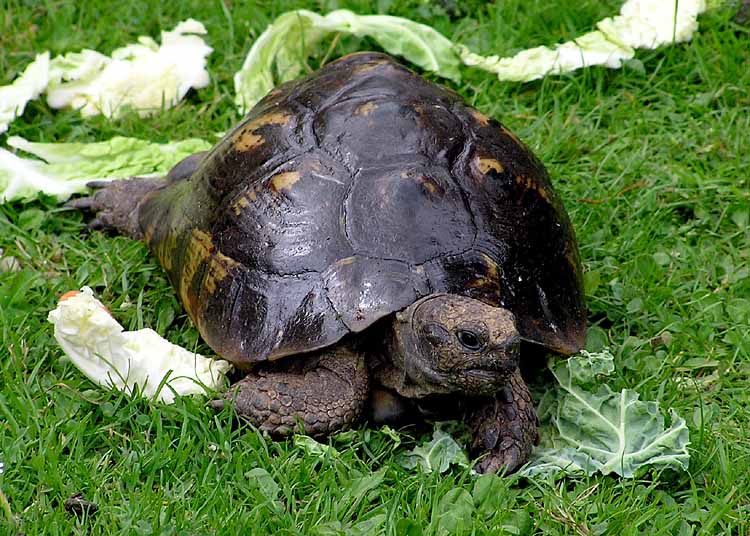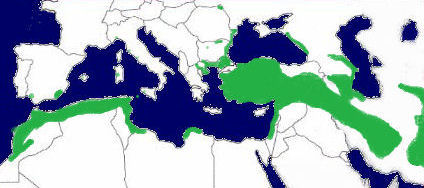- Spur-thighed Tortoise
Taxobox
name = Spur-thighed Ibera Tortoise

image_width = 240px
status = VU
status_system = iucn2.3
regnum =Animal ia
phylum =Chordata
classis = Sauropsida
ordo =Testudines
subordo =Cryptodira
familia =Testudinidae
genus = "Testudo"
species = "T. graeca"
binomial = "Testudo graeca"
binomial_authority = Linnaeus,1758
range_
range_map_width = 240px
range_map_caption = Noteallopatric ranges of "Maghreb" ("graeca") and "Greek" ("ibera") populationsThe Spur-thighed Tortoise is one of four European members of the
Testudinidae family oftortoise s. The other members of the family areHermann's Tortoise ("Testudo hermanni"), theMarginated Tortoise ("Testudo marginata") andHorsfield's Tortoise ("Testudo horsfieldii").Characteristics
The Greek Tortoise ("Testudo graeca ibera") is often confused with Hermann's Tortoise ("Testudo hermanni"). However, there are nine notable differences that enable them to be distinguished.
ubspecies
The division of Greek Tortoises into subspecies is difficult and confusing. Given the huge range over three continents, the various terrains, climates, and biotopes have produced a huge number of varieties, with new subspecies constantly being discovered. There are currently at least twenty published subspecies.
* "T. graeca graeca", North Africa, southern Spain, Sardinia, the Baleares "Maghreb Tortoise" or "Spur-thighed Tortoise"
* "T. graeca ibera", Turkey, Greece, FYROM, Bulgaria, Romania, "Eurasian Tortoise"
* "T. graeca anamurensis", Turkey, "Anamur Tortoise"
* "T. graeca terrestris", southern Israel, "Levantine Tortoise"
* "T. graeca armenica", Armenia, "Armenian Tortoise"
* "T. graeca nikolskii", Caucasus, "Caucasian Tortoise"
* "T. graeca buxtoni", Caspian Sea area, "Caspian Tortoise"
* "T. graeca pallasi", Dagestan, "Dagestani Tortoise"
* "T. graeca marokkensis", Morocco
* "T. graeca lamberti", Morocco
* "T. graeca soussensis", Morocco
* "T. graeca nabeulensis", Tunisia, (Tunisian Spur-thighed Tortoise )
* "T. graeca floweri"
* "T. graeca antakyensis"
* "T. graeca flavominimaralis", Libya (Libyan Tortoise)This incomplete listing shows the problems in division into subspecies. The differences in form are primarily in size and weight, as well as coloration, which ranges from dark brown to bright yellow, and the types of flecks, ranging from solid colors to many spots. Also, the bending-up of the edges of the
carapace ranges from minimal to pronounced. So as not to become lost in the number of subspecies, recently a few tortoises previously classified as "Testudo graeca" have been assigned to different species, or even different genera.The genetic richness of "Testudo graeca" is also shown in their crossbreeding. Tortoises of different form groups often mate, producing offspring with widely differing shapes and color. Perhaps the best means of identification for the future is simply the place of origin.
The smallest, and perhaps the prettiest, of the subspecies is the
Tunisian Spur-Thighed Tortoise . It has a particularly bright and striking coloration. However, these are also the most sensitive tortoises of the species, so that they cannot be kept outdoors in temperate climates, as cold and rainy summers quickly cause the animals to become ill. They are also incapable of a longhibernation .At the other extreme, animals from northeastern Turkey are very robust, like
Hermann's Tortoise . The largest specimens come from Bulgaria. Specimens of 7 kg (15 lb) have been reported. In comparison, the Tunisian Tortoise has a maximum weight of 0.7 kg (1.5 lb). "Testudo graeca" is also closely related to theMarginated Tortoise ("Testudo marginata"). The two species can interbreed, producing offspring capable of reproduction.Identification of sex
Males differ from females in 6 main points. Firstly, they are generally smaller. Their tails are longer and taper to a point evenly, and the cloacal opening is farther from the base of the tail. The underside is somewhat curved, while females have a flat shell on the underside. The rear portion of a male's carapace is wider than it is long. Finally, the posterior plates of the carapace often flange outward.
Mating and reproduction
Immediately after waking from hibernation, the mating instinct starts up. The males follow the females with great interest, encircling them, biting them in the limbs, ramming them, and trying to mount them. During
copulation , the male opens his mouth, showing his red tongue and making squeaking sounds. During mating, the female stands still, bracing herself with her front legs, moving the front part of the body to the left and right in the same rhythm as the male's cries. One successful mating will allow the female to lay eggs multiple times. When breeding in captivity, the pairs of females and males must be kept separate. If there are multiple males in a pen, one takes on a dominant role and will try to mate with the other males in the pen. If there are more males than females, the males might kill each other in order to mate with the female.One or two weeks before egg-laying, the animals become notably agitated, moving around to smell and dig in the dirt, even tasting it, before choosing the ideal spot to lay the eggs. One or two days before egg laying, the female takes on an aggressive, dominant behavior, mounting another animal as for copulation and making the same squeaking sound the male produces during copulation. The purpose for this behavior is to produce respect in the tortoise community, so that the female will not be disturbed by the others during egg laying. Further details of egg-laying behavior are the same as those detailed for the
Marginated Tortoise .References
*IUCN2006|assessors=Tortoise & Freshwater Turtle Specialist Group|year=1996|id=21646|title=Testudo graeca|downloaded=09 May 2006 Listed as Vulnerable (VU A1cd v2.3)
External links
* [http://www.mayer-richard.de/ European Tortoises (in German)]
Wikimedia Foundation. 2010.
